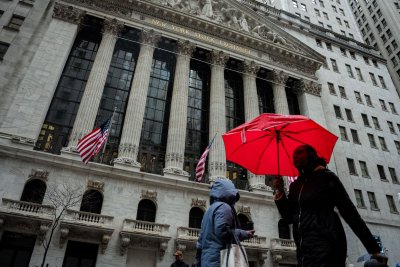
April 11 (UPI) — U.S. stocks rose on Friday as Wall Street ended a roller-coaster week amid a trade war involving tariffs started by the United States.
Investors expressed optimism after the White House said it was in favor of a trade idea with China. The Asian nation on Friday retaliated with the same 125% duty from 84% after the United States enacted the same figure on top of 20% for a total of 145%.
The major indexes moved up from Friday’s close and are about 5% above last week’s close but down year to date.
The Standard and Poor’s 500 increased 1.8% from Thursday, while the Dow Jones Industrial Average climbed 1.6% and the Nasdaq Composite rose 2.1.%.
After President Donald Trump imposed reciprocal tariffs on April 2 for the worst trade offenders and 10% for nearly all trading partners, the market had four down days in a row.
Then, when Trump rescinded the higher rates, the market skyrocketed, including 2,963 points by the DJA index. Then, on Thursday, stocks dropped again on the wide-ranging effects of the tariffs on China.
“We remain in the early innings of this global trade regime change, and while the 90-day pause on reciprocal tariffs temporarily reversed the market selloff, it does prolong uncertainty,” Wells Fargo Investment Institute president Darrell Cronk wrote in a note Friday obtained by CNBC.
Other tariffs include 25% on aluminum, autos and goods from Canada and Mexico that aren’t part of the United States-Mexico-Canada agreement.
The major indexes are down significantly from record highs.
On Friday, S&P 500 finished up 95.31 points, to 5,363.36. The S&P had dropped below 5,000 at one point and was in a bear market from its record of 6,147.43 in February. The drop is now 12.8%, considered a correction with a bear market at 20%.
DJIA jumped 619.05, to 40,212.71. The DJIA hit 45,014 on Dec. 4 but went under 40,000 with the last time Aug. 13. The DJIA is down 10.7% from the high.
The tech-heavy Nasdaq Composite jumped 337.14 points to 16,724.46. The index went into a bear market one Friday ago for the first time since 2022 but is now down 17.1% from a record high of 20,173.89 on Dec. 16.
At last week’s close, the S&P was 5% lower at 5,074.08, DJIA down 5% at 38,314.86 and Nasdaq 6.7% lower at 15,587,79.
The 10-year Treasury yield was at 4.48% Friday, a rise of 0.09, as investors made safety grabs of bonds, which lowered rates and lifted prices. It had reached 4.4% Wednesday morning, which was up from 3.9% before Trump unveiled the new tariffs earlier this month.
West Texas Intermediate Crude for May was up $1.51 to $61.60 a barrel, reflecting energy traders’ concerns fuel demand will decline. Earlier this week it went under $60, with the last time it was under that barrier was in April 2021.
And gold was trading at a record $3,249.30 and ounce, up $71.80 as investors look to metals amid uncertainty about tariffs and the economy. It has been above $3,000 since Monday.
Consumer sentiment slumped to 11%, according to a University of Michigan survey released Friday. This is the second-lowest reading since 1952.
“Trust in President Trump, he knows what he’s doing,” White House press secretary Karoline Leavitt said Friday. “This is a proven economic formula.”
Trump earlier this week warned of “transition cost” after saying Americans would face short-term pain and disruption.
“Look at what he did in his first term,” Leavitt said.
The day before Trump took office Jan. 20, the DJIA was at 19,804,72. It was 31,220.46 when he left office.
Market sectors
All sectors tracked by CNBC rose Friday.
Materials led the way with a 2.99% rise, followed by technology at 2.56%. All others were below 2%, with communications services the smallest at 1.1%.
The stock price of Apple, which makes computers and cellphones in China, rose 4.06% after several down days. Chipmaker Nvidia gained 3.12%.
Nike, which depends on international supply chains and imports from Vietnam, was down 0.018%.
U.S. auto stocks rose as 46% of cars sold in the United States come from other nations.
Tesla, which makes most of its cars in the United States but imports parts, was down 0.064% to 252.24. The record high was 479.86 on Dec. 17 and it was half that price earlier in the week.
Ford, which makes fewer cars outside the United States than other major companies, rose $2.08. General Motors was down 0.23% and Stellantis dropped 0.45%.
Stellantis, the parent company of Chrysler and Dodge, also owns foreign brands such as Jeep, Ram, Alfa Romeo, Fiat and Maserati.
Airlines’ stocks spiked, led by United Airlines rising 4.54%, followed by Delta Airlines 3.84%, American Airlines 1.68% and Southwest Airlines 1.55%. Spirit, which left Chapter 11 bankruptcy in March, is no longer a public company.